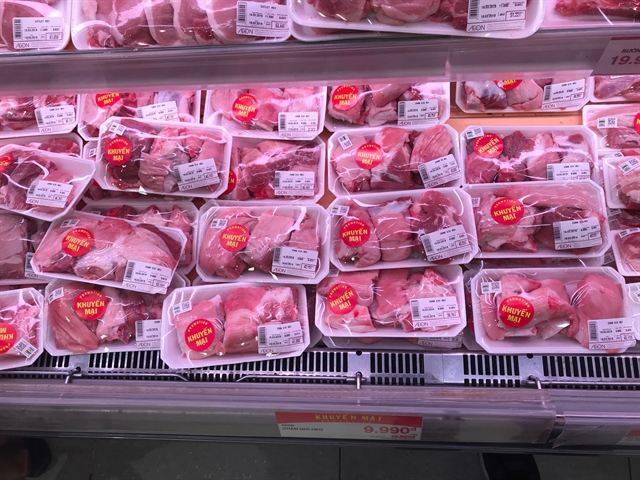 Economy
Economy

After Việt Nam’s pork industry was hit hard by the outbreak of African Swine Flu and COVID-19, the Ministry of Agriculture and Rural Development (MARD) say they will increase pork imports to reduce prices for the domestic market.

|
| Việt Nam will increase pork imports to meet domestic demand. — Photo vietnammoi.vn |
HÀ NỘI — After Việt Nam’s pork industry was hit hard by the outbreak of African Swine Flu and COVID-19, the Ministry of Agriculture and Rural Development (MARD) say they will increase pork imports to reduce prices for the domestic market.
Deputy Minister of Agriculture and Rural Development Phùng Đức Tiến was speaking at an online conference promoting agricultural production during the novel coronavirus (COVID-19) pandemic held by MARD in Hà Nội on Thursday.
He said MARD representatives visited the US at the end of February to discuss issue of agricultural trade promotion between the two countries, including the increase of pork imports in the future.
Earlier this month, MARD leaders worked with the President of Russian Miratorg Group to promote trade activities in agriculture, forestry and fishery sectors.
The group hopes to export more pork to Việt Nam this month, Tiến said.
Meanwhile, the ministry has been completing procedures to import livestock from Laos and Cambodia.
According to the ministry, Việt Nam imported 65,865 tonnes of meat in the first two months this year from Brazil, Germany, Russia, Australia and the US. Of which, pork imports reached 13,816 tonnes, up 150 per cent over the same period in 2019.
Imports also included 12,459 tonnes of buffalo meat and beef, and 26,656 tonnes of poultry.
Tiến said the ministry has asked large enterprises to further reduce the price of pigs to around VNĐ70,000 per kilo to ensure stable price on the domestic market.
Higher imports mean more supply, which will help bring the price down, he said.
The ministry would coordinate with the Ministry of Industry and Trade and the Ministry of Finance to keep checking on prices to prevent speculation.
At the same time, to stabilise the price, the agriculture sector needs to speed up re-production, according to the ministry. African swine fever has made national pork output reduce sharply.
The livestock sector has 2.7 million sows, meeting demand on re-production. Pork output is expected reach about four million tonnes this year.
In addition, other kinds of livestock are expected to continue to have strong growth, including poultry with a rate of 13 per cent and beef up 5 per cent. The total output of poultry meat and beef is estimated to reach 1.8 million tonnes this year.
With a total meat output of 5.8 million tonnes this year, Việt Nam would have enough meat supply for domestic consumption, said Nguyễn Văn Việt, head of MARD’s Department of Planning.
During the conference, Minister of Agriculture and Rural Development Nguyễn Xuân Cường said localities should promote agricultural production while the ministry would take measures to control diseases. Those solutions would help prepare enough supply to meet higher demand for farming product when the pandemic ends.
The ministry would also continue developing key seafood products, such as black tiger shrimp, white-leg shrimp and tra catfish, and high-value farming products to increase commercial value.
The industry would diversify exports and develop the processing industry to raise added value, Cường said. It would also cooperate with the Ministry of Industry and Trade and Vietnamese embassies abroad to improve efficiency of trade promotion programmes.
Việt said the agricultural sector has seen a surplus of US$1.04 billion in the first two months of this year. It saw a year on year reduction of 6.7 per cent in import value to $4.3 billion and a year on year drop of 2.8 per cent in export value to $5.34 billion.
This year, the sector has targeted $42 billion in total export value of farming, forestry and fishery products, including $20 billion from farming products, $11.5 billion from forestry and wooden products and $10 billion from fishery products. — VNS




